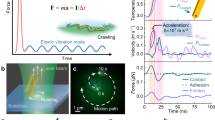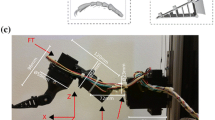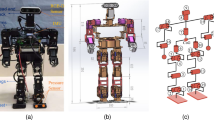Abstract
In this paper, we introduce the SerpenBot, a microrobot smaller than 1 mm in size, powered by laser energy, and designed to operate in dry environments. The microrobot achieves locomotion on a silicon substrate by selective coupling of laser energy between two legs that move the robot forward and steer it. The laser energy coupling mechanism is achieved by selective energy-time irradiation of the microrobot’s body and legs to initiate the gait. Complex multi-physics models developed in our past work are simplified to a differential drive kinematic model that approximates the robot behavior and is used to formulate a deep learning controller that can steer the robot to desired locations on the substrate. Simulations predict the robot position regulation achieved by deep learning of the inverse robot Jacobian. Experimental results are presented confirming that the microrobot can be automatically steered to a goal location using a simple PD controller.


















Similar content being viewed by others
Data availability
All data and video used in this paper have been uploaded and submitted and shareable.
References
Rahman MA, Ohta AT (2021) Micromanipulation with microrobots. IEEE Open J Nanotechnol 2:8–15
Nelson BJ, Kaliakatsos IK, Abbott JJ (2010) Microrobots for minimally invasive medicine. Annu Rev Biomed Eng 15(12):55–85
Ceylan H, Giltinan J, Kozielski K, Sitti M (2017) Mobile microrobots for bioengineering applications. Lab Chip 17:1705
Palagi S, Fischer P (2018) Bioinspired microrobots. Nat Rev Mater 3:113–124
Feng J, Cho SK (2014) Mini and micro propulsion for medical swimmers. Micromachines 5(1):97–113
Zhang Li, Abbott JJ, Dong L, Kratochvil BE, Bell D, Nelson BJ (2009) Artificial bacterial flagella: Fabrication and magnetic control. Appl Phys Lett 94:064107
Steager EB, Selman Sakar M, Magee C, Kennedy M, Cowley A, Kumar V (2013) Automated biomanipulation of single cells using magnetic microrobots. Int J Robot Res 32(3):346–359
Yao T, Chisholm NG, Steager EB, Stebe KJ (2020) Directed assembly and micro-manipulation of passive particles at fluid interfaces via capillarity using a magnetic micro-robot. Appl Phys Lett 116(4):043702
Li Z, Diller E (2017) Polymer filament–based in situ microrobot fabrication using magnetic guidance. Int J Adv Robot Syst 14(1)
Hu X, Yasa IC, Ren Z, Goudu SR, Ceylan H, Hu W, Sitti M (2021) Magnetic soft micromachines made of linked microactuator networks. Sci Adv 7(23):eabe8436
Elbuken C, Khamesee MB, Yavuz M (2009) Magnetic levitation as a micromanipulation technique for MEMS. Int Conf Mechatron Autom 2009:955–959
Qiu T, Lee TC, Mark A et al (2014) Swimming by reciprocal motion at low Reynolds number. Nat Commun 5:5119
Alcântara CCJ, Landers FC, Kim S et al (2020) Mechanically interlocked 3D multi-material micromachines. Nat Commun 11:5957
Miyashita Shuhei et al (2017) Robotic metamorphosis by origami exoskeletons. Sci Robot 2(10):4369
Ryan P, Diller E (2017) Magnetic actuation for full dexterity microrobotic control using rotating permanent magnets. IEEE Trans Rob 33(6):1398–1409
Kim H, Kim MJ (2016) Electric field control of bacteria-powered microrobots using a static obstacle avoidance algorithm. IEEE Trans Rob 32(1):125–137
Dillinger C, Nama N, Ahmed D (2021) Ultrasound-activated ciliary bands for microrobotic systems inspired by starfish. Nat Commun 12:6455
Luo T, Wu M (2021) Biologically inspired micro-robotic swimmers remotely controlled by ultrasound waves. Lab Chip 21:4095
Jafferis NT, Helbling EF, Karpelson M et al (2019) Untethered flight of an insect-sized flapping-wing microscale aerial vehicle. Nature 570:491–495
Miskin MZ, Cortese AJ, Dorsey K et al (2020) Electronically integrated, mass-manufactured, microscopic robots. Nature 584:557–561
Rahman MA, Cheng J, Wang Z et al (2017) Cooperative micromanipulation using the independent actuation of fifty microrobots in parallel. Sci Rep 7:3278
Glückstad J, Villangca MJ, Palima DZ, Bañas AR (2017) Light-actuated microrobots for biomedical science. SPIE Newsroom. https://spie.org/news/6860-light-actuated-microrobots-for-biomedical-science?SSO=1
Zhang D, Barbot A, Lo B, Yang G-Z (2020) Distributed force control for microrobot manipulation via planar multi-spot optical tweezer. Adv Optical Mater 8:2000543
Banerjee AG et al (2014) Optical tweezers: Autonomous robots for the manipulation of biological cells. IEEE Robot Autom Mag 21(3):81–88
Shakoor Adnan et al (2021) Automated optical tweezers manipulation to transfer mitochondria from fetal to adult mscs to improve antiaging gene expressions. Small 17(38):2170199
Wu X, Ehehalt R, Razinskas G, Feichtner T, Qin J, Hecht B (2022) Light-driven microdrones. Nat Nanotechnol 17(5):477–484
Dong X, Kheiri S, Lu Y, Xu Z, Zhen M, Liu X (2021) Toward a living soft microrobot through optogenetic locomotion control of Caenorhabditis elegans. Sci Robot 6(55):eabe3950
Pac MR, Popa DO (2011) 3-DOF untethered microrobot powered by a single laser beam based on differential thermal dynamics. IEEE Int Conf Robot Autom 2011:121–127
Zhang R, Sherehiy A, Yang Z, Wei D, Harnett CK, Popa DO (2019) ChevBot – an untethered microrobot powered by laser for microfactory applications. Int Conf Robot Autom (ICRA) 2019:231–236
Zhang R, Sherehiy A, Wei D, Yang Z, Saadatzi MN, Popa DO (2019) Tracking experiments with ChevBot: a laser-actuated stick-slip microrobot. In: 2019 International Conference on Manipulation, Automation and Robotics at Small Scales (MARSS), Helsinki, pp 1–6
Yang Z, Sherehiy A, Chowdhury SS, Wei D, Zhang R, Popa DO (2020) Design, fabrication and experimental validation of a steerable, laser-driven microrobot in dry environments. In: IEEE 16th International Conference on Automation Science and Engineering (CASE), vol 2020, Hong Kong, pp 882–887
Yang Z et al (2022) SerpenBot, a laser driven locomotive microrobot for dry environments using learning control. In: 2022 International Conference on Manipulation, Automation and Robotics at Small Scales (MARSS), Toronto, pp 1–6
Chowdhury SS, Yang Z, Clapacs PW, Popa DO (2021) Untethered microrobots with serpentine actuators: the role of elastics point contact & laser beam shape on their locomotion. In: Proceedings of the ASME 2021 16th International Manufacturing Science and Engineering Conference. Volume 2: Manufacturing Processes; Manufacturing Systems; Nano/Micro/Meso Manufacturing; Quality and Reliability. Virtual, Online. V002T08A008. ASME
Yang Z et al (2019) Multiphysics dynamic model validation methodology for laser-driven microrobots. In: 2019 IEEE 15th International Conference on Automation Science and Engineering (CASE), Vancouver, pp 1555–1561
Asada M, Tanaka T, Hosoda K (2000) Adaptive binocular visual servoing for independently moving target tracking. In: Proceedings 2000 ICRA. Millennium Conference. IEEE International Conference on Robotics and Automation. Symposia Proceedings (Cat. No.00CH37065), vol 3, San Francisco, pp 2076–2081
Sebastián JM, Pari L, González C, Ángel L (2005) A new method for the estimation of the image jacobian for the control of an uncalibrated joint system. In: Marques JS, Pérez de la Blanca N, Pina P (eds) Pattern recognition and image analysis. IbPRIA 2005. Lecture notes in computer science, vol 3522. Springer, Berlin, Heidelberg
Siegwart R, Nourbakhsh IR, Scaramuzza D (2011) Introduction to autonomous mobile robots, 2nd edn. MIT Press, London
Piepmeier JA, McMurray GV, Lipkin H (2004) Uncalibrated dynamic visual servoing. IEEE Trans Robot Autom 20(1):143–147
Bradley J (1995) Neural networks: a comprehensive foundation: S. Haykin. New York: Macmillan College (IEEE Press Book) (1994). v + 696 pp. Inf Process Manag 31:786
Funding
This work was supported by the EPSCOR KAMPERS #1849213 project funded by the National Science Foundation. We wish to thank the Micro Nano Technology Center staff at University of Louisville for help with cleanroom fabrication and enabling access to the SEM.
Author information
Authors and Affiliations
Contributions
Zhong Yang designed and fabricated the SerpenBot, proposed and realized motion control automation approach based on neural network, developed PID controller, conducted simulations, participated in experiments, analyzed, and processed experimental, data, and finally wrote the paper drafts.
Moath Alqatamin contributed to development of: SerpenBot PID controller, motion control part of the experimental setup, NI Labview user interface.
Andriy Sherehiy directly supervised the experimental part of the study and conducted experiments, co-designed, supervised and participated in building of experimental setup, proposed SerpenBot steering mechanism, contributed to the writing of the manuscript.
Ruoshi Zhang contributed to the microrobot's design, supervised, and participated in its fabrication process.
Mojtaba Al Hudibi conducted experiments, assisted with analysis and processing of experimental data, responsible for the handling of the microrobots.
Sri Sukanta Chowdhury contributed to the SerpenBot design, proposed SerpenBot steering mechanism, designed experimental set up.
Alireza Tofangchi, co-designed and participated in building of experimental setup, contributed to manuscript.
Dan O. Popa is a head of the Next Generations Systems laboratory and principal investigator, he is the co-author of the original concept of the laser driven microscale robot, contributed to the manuscript.
Corresponding author
Ethics declarations
Competing interests
Not applicable.
Additional information
Publisher's Note
Springer Nature remains neutral with regard to jurisdictional claims in published maps and institutional affiliations.
Supplementary Information
Below is the link to the electronic supplementary material.
Rights and permissions
About this article
Cite this article
Yang, Z., Alqatamin, M., Sherehiy, A. et al. Learning control of a laser-driven locomotive microrobot for dry environments. J Micro-Bio Robot 18, 101–119 (2022). https://doi.org/10.1007/s12213-023-00162-9
Received:
Revised:
Accepted:
Published:
Issue Date:
DOI: https://doi.org/10.1007/s12213-023-00162-9




